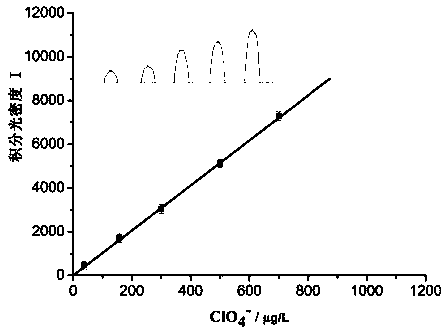Method for analyzing and determining perchlorate in food by utilizing DLLME and digital image of scanner
A digital image, perchlorate technology, applied in the direction of analyzing materials, material analysis by optical means, instruments, etc., to achieve the effect of low cost of instruments and high application prospects
- Summary
- Abstract
- Description
- Claims
- Application Information
AI Technical Summary
Problems solved by technology
Method used
Image
Examples
Embodiment 1
[0024] The detection of perchlorate content in embodiment 1, milk
[0025] (1) Milk sample pretreatment: Add 5.0 mL milk solution into a 50 mL polypropylene conical tube, add 5.0 mL 1.0% acetic acid aqueous solution and 20.0 mL acetonitrile. Cover the centrifuge tube cap and shake vigorously for 5 minutes. The mixture was centrifuged at 6000 rpm for 20 min. Use a nylon syringe filter with a pore size of 0.20 μm to take the supernatant. Before measurement, filter all digested samples through ultrafiltration membranes with a pore size of 4 nm;
[0026] (2) ClO 4 - Detection: Add 0.5-6mL sample to a 15mL centrifuge tube, add 0.4mL 0.10g·L -1methylene blue solution, then add 1.0mL HAc-NaAc buffer solution (pH=4.5), dilute to 10mL, quickly inject 600μL dichloromethane and methanol (v:v=2:1) solution into the target analysis via a micro syringe to induce the formation of a turbid solution, and the mixture was shaken vigorously on a vortex shaker for 2 min. Use a centrifuge ...
Embodiment 2
[0027] Embodiment 2, the detection of perchlorate content in tap water
[0028] (1) Obtained in the laboratory and analyzed directly without any pretreatment.
[0029] (2) ClO 4 - Detection: Add 1-6mL sample to a 15mL centrifuge tube, add 0.4mL 0.10g·L -1 methylene blue solution, then add 1.0mL HAc-NaAc buffer solution (pH=4.5), dilute to 10mL, quickly inject 600μL dichloromethane and methanol (v:v=2:1) solution into the target analysis via a micro syringe to induce the formation of a turbid solution, and the mixture was shaken vigorously on a vortex shaker for 5 min. Use a centrifuge to centrifuge at 4000rpm for 5min, remove the upper aqueous phase; use a micro-sampler to take 4.0 μL of the enriched phase point on inkjet printing paper, and use a scanner to scan the sample piece of paper after the solvent is air-dried, and then use GIMP and ImgeJ software software to convert the scanned image into a grayscale mode, select the grayscale sample spot area area to integrate...
Embodiment 3
[0030] The detection of perchlorate content in embodiment 3, spinach
[0031] (1) Sample pretreatment: Dry the sample at 120°C, grind it into fine powder in a mortar, and sieve it with 80 mesh. Put 10.0g of dried spinach sample into a 100mL Erlenmeyer flask, add 30mL of concentrated nitric acid, and place it at room temperature for 20 hours for digestion. The second is to add 10mL of concentrated nitric acid and hydrogen peroxide dropwise, and heat at 150°C on an electric heating plate to drive out the nitric acid. Repeat the process until the solution is clear. After the solution is cooled, add secondary water to make up to volume.
[0032] (2) ClO 4 - Detection: Add 0.5-6mL sample to a 15mL centrifuge tube, add 0.4mL 0.10g·L -1 methylene blue solution, then add 1.0mL HAc-NaAc buffer solution (pH=4.5), dilute to 10mL, quickly inject 600μL dichloromethane and methanol (v:v=2:1) solution into the target analysis via a micro syringe to induce the formation of a turbid so...
PUM
 Login to View More
Login to View More Abstract
Description
Claims
Application Information
 Login to View More
Login to View More - R&D
- Intellectual Property
- Life Sciences
- Materials
- Tech Scout
- Unparalleled Data Quality
- Higher Quality Content
- 60% Fewer Hallucinations
Browse by: Latest US Patents, China's latest patents, Technical Efficacy Thesaurus, Application Domain, Technology Topic, Popular Technical Reports.
© 2025 PatSnap. All rights reserved.Legal|Privacy policy|Modern Slavery Act Transparency Statement|Sitemap|About US| Contact US: help@patsnap.com



